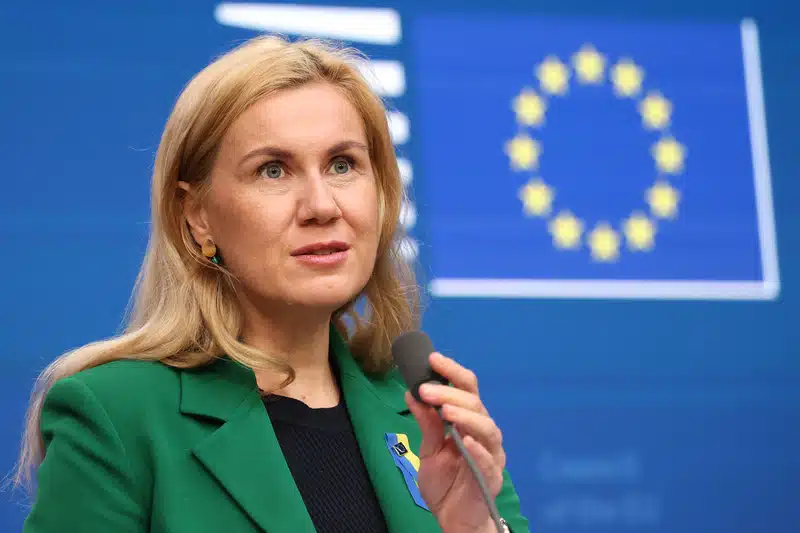Strasbourg, from the correspondent – Reduce net greenhouse gas emissions by 90 per cent by 2040 as an intermediate step toward climate neutrality by mid-century: The European Commission adopted its recommendation today (Feb. 6) on the new interim climate target for 2040, following on the figures what was recommended in Brussels by the European Scientific Advisory Committee on Climate Change.
As expected, the communication adopted today by the college in Strasbourg is not a full-fledged legislative proposal: Brussels presented only a recommendation, in the form of a commission communication, accompanied by a detailed impact assessment for three hypothetical scenarios. The next commission will then have the political responsibility to propose legislation on the 2040 target and accompanying policy framework for the period after 2030, after the European elections and probably in early 2025. A recommendation, then, to “launch the debate” among EU member states, as summarized by the European Commissioner for Climate Action, Wopke Hoekstra, presenting the initiative in a dedicated debate.

Energy efficiency, buildings and industry, agriculture and hydrogen transport. In the communication, Brussels identified a group of 8 areas (from the energy system to the agricultural sector) in which it recommends that member states put in place “decisive measures” to contribute to the 2040 target and create “favourable conditions” to achieve it. According to the estimates, it will be necessary to invest “an additional 1.5 per cent of Gross Domestic Product annually over the 2011-2020 decade in the transition, shifting resources away from less sustainable uses such as fossil fuel subsidies,” and it will be the private sector that will make “most of these investments if the policy framework will incentivize low-carbon investments and discourage carbon-intensive ones.”
Due to the protests in recent weeks by farmers across Europe, the Commission has amended and weakened part of the recommendation dealing with the agricultural sector, removing any reference to the need for agriculture to reduce “emissions by 30 per cent by 2040 compared to 2015 levels,” as was planned in an early draft of the communication that Eunews had viewed.
In the recommendation, Brussels recognizes that “like all other sectors, agricultural activities play an important role in achieving the EU’s 2040 climate ambitions while contributing to food sovereignty.” According to the EU executive, “with effective policies that reward good practices and appropriate support,” the sector “can also contribute to reducing emissions and providing other vital services, such as improving the capacity of soils and forests to store more carbon,” it says, without including specific targets that would be too slippery ahead of the June 6-9 European elections.
European climate law and the 2040 target
The European Climate Act (adopted in Brussels in 2021) set a target to reduce greenhouse gas emissions by 55 per cent by 2030 and committed the European Union, among other things, to set a new interim target for 2040 and an indicative projected budget for the Union’s greenhouse gases for the period 2030-2050, that is, how much net greenhouse gas emissions can be emitted in that timeframe without jeopardizing the Union’s commitments.
Thus, 2040 is the second interim target before reaching carbon neutrality in 2050. After 2050, emissions are considered negative: that is, there can be no new emissions, but existing ones will remain. The timing of discussions for 2040 is closely tied to the five-year ambition cycle of the 2015 Paris Climate Agreement, which sets a commitment to limit temperature increase to within 1.5°C. To meet the target of 90 per cent below 1990 levels, Brussels estimates, “the EU’s remaining greenhouse gas emissions in 2040 should be below 850 megatons of CO₂ equivalent and carbon removals (from the atmosphere) should reach 400 MtCO₂e,” the communication reads.
Nuclear energy and storage for the 2040 target
Not just renewables to meet the 2040 interim target: In publishing the recommendation, Brussels emphasizes the role that clean energy will play in lowering emissions but also admits that it must invest in technologies to manage carbon industrially and in low-emission technologies, such as nuclear. Therefore, in parallel, the Commission has issued a communication dedicated to creating a European market for technologies that can capture CO2 or remove it directly from the atmosphere and then store or use it.

Kadri Simson
Brussels has set a target of 50 million tons per year of CO2 storage capacity by 2030, rising to 280 million tons by 2040 to contribute to the 90 per cent emissions reduction target by then (compared to 1990 levels). The communication, which has no legislative value, focuses on three technologies in particular: those that capture CO2 for storage (so-called CCS); those that capture CO2 for use (CCUs); and then technologies for removing CO2 directly from the atmosphere, which are the techniques that are also currently the most expensive according to the International Energy Agency. There are no binding targets in the communication, but Brussels lets it be known that it will begin preparatory work to publish a “regulatory package for CO2 transport and storage,” which will consider market, cost structure, and third-party access.
Brussels then formalized its intention to launch an Industrial Alliance on Small Modular Nuclear Reactors “to improve industrial competitiveness and ensure a robust EU supply chain and skilled workforce.” At a press conference, European Energy Commissioner, Kadri Simson, anticipated that the Commission will open the call for applications to join the initiative, which will be officially launched in the coming months, probably on Thursday.
The purpose of the Alliance will not be legislative but to bring together governments, industry players, and stakeholders who seek to accelerate the development of the industry, noting a growing interest of several member states in nuclear technologies. Small modular reactors are nuclear reactors that are smaller in both power and physical size than conventional gigawatt-scale power plants, ranging from 10 to 300 MegaWatts. They are based on existing technologies and are designed to be factory-built in standard modular form, and their main advantage is that they can be assembled in the factory and then shipped and installed on-site, thus even in remote areas with limited grid capacity or in areas where the use of large conventional nuclear power plants is not possible.
Eurofer, the European steel industri association replays disappointed that “we urgently need an investment-friendly framework with affordable energy and an international playing field at its core to support the EU’s industrial transition, rather than focusing solely on an abstract debate on target-setting”.
The European Commission, states Copa-Cogeca, the main European farmers association “has taken a pragmatic approach in looking at “enabling policy conditions” that could support further GHG reduction by 2040 in the farming sector”. At first glance, Copa and Cogeca “welcome mainly the willingness to strengthen the bioeconomy sector and the renewed interest to talk to farmers in the framework of the strategic dialogue. The ongoing outreach will help the next Commission to table legislative proposals for the post-2030 policy framework, which will deliver the 2040 target in a fair and cost-efficient manner”.
In its communication on Industrial Carbon Management, the Commission is exploring carbon pricing frameworks for hard-to-abate sectors, including agriculture. Copa and Cogeca “took stock of the Commission’s proposal to set up a dedicated taskforce to develop a global approach to carbon pricing and carbon markets”.
After the European elections, “the next Commission will propose a revision of the EU Climate Law to make the EU 2040 Target legally-binding. Europe’s farmers, forest owners and their cooperatives expect the new Commission to support the sector in continuing to deliver concrete actions to reduce their emissions, whilst feeding a fast-growing population and providing sustainable alternative to fossil-based materials”.
English version by the Translation Service of Withub






